Are you ready to dive into the world of 30,000 steps and the incredible journey it entails? Lace up your walking or running shoes and join us as we embark on a thrilling exploration of the miles, minutes, and myriad benefits associated with this substantial step count. In this comprehensive blog, we will discuss on how many miles in 30000 steps.
We’ll unravel the mysteries surrounding 30,000 steps, revealing not only the distance they cover but also the calories they burn, the health benefits they offer, and the potential challenges you might encounter along the way. Whether you’re aiming to boost your fitness regimen or satisfy your curiosity, our journey into the realm of 30,000 steps promises to be both enlightening and inspiring. So, let’s take that first step together and discover the incredible mileage, moments, and experiences that await!
This blog will cover the notion and suggestions from the experts. So, all the points and words in this blog reflect the opinion of the experts. Here, we have John Markell and Aaron Charnay as experts.
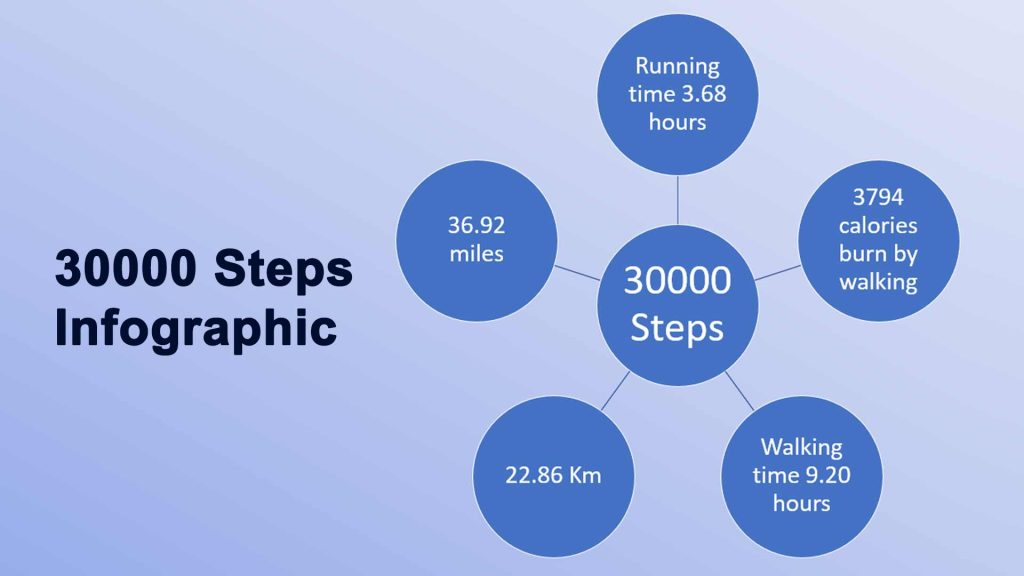
How many miles in 30000 steps?
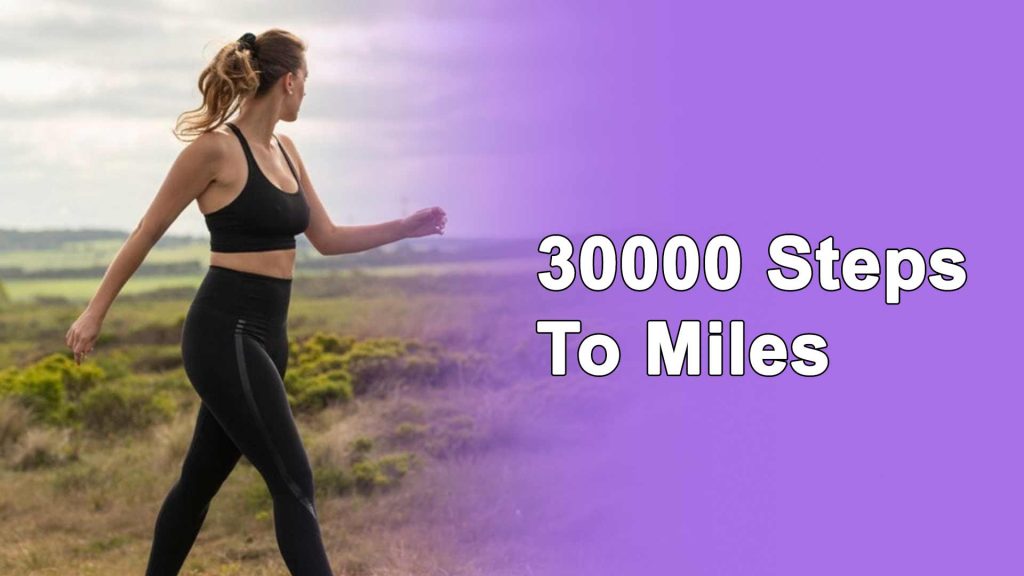
Do you know how many miles in 30000 steps? According to John Markell, walking 30,000 steps is equivalent to covering approximately 14.13 miles. This means that if you were to embark on a journey of 30,000 steps, you would be traversing a distance that’s nearly 14.13 miles long. To put that into perspective, it’s like walking from one town to another or completing a marathon!
To determine how many miles are covered in 30,000 steps, we can use the conversion rate of 2,118 steps equal to 1 mile. Here’s how you can calculate it:
- Calculate how many miles are covered by one step:1 mile / 2,118 steps ≈ 0.000471 miles per step
- Multiply the number of steps (30,000) by the miles per step to find the total distance in miles:30,000 steps * 0.000471 miles per step ≈ 14.13 miles
So, 30,000 steps are approximately equal to 14.13 miles. This calculation is based on the assumption that each step covers the same distance, which may not be entirely accurate due to variations in stride length and terrain. However, it provides a reasonable estimate of the distance covered.
How many miles in 30000 steps for different height ranges?
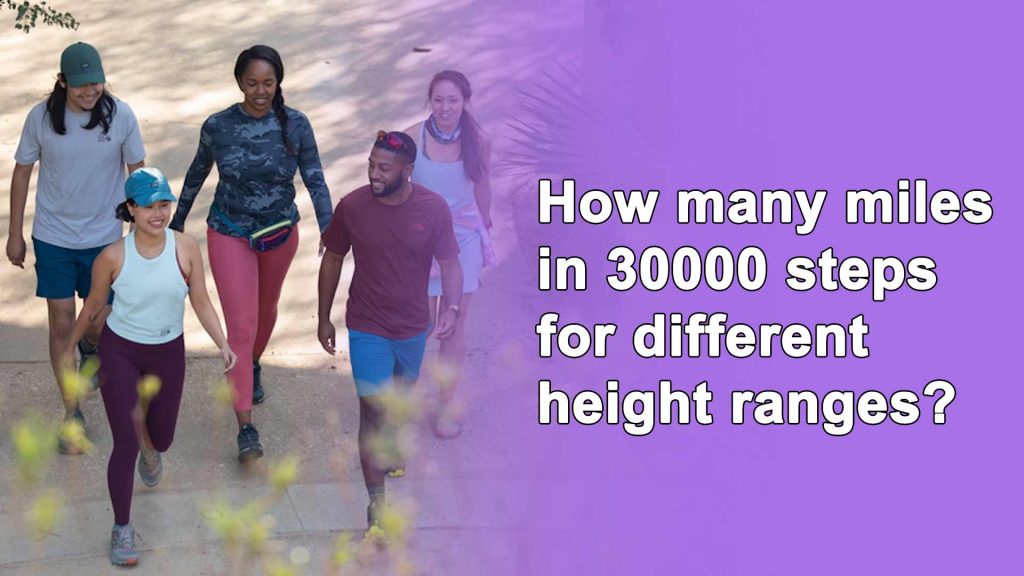
To calculate how many miles are covered in 30,000 steps for different height ranges, we’ll use the below stride length information for each height range. Here are the calculations:
- For Height Range 6.00 to 7.00 Feet (2,031 steps per mile):
- 30,000 steps / 2,031 steps per mile ≈ 14.77 miles
- For Height Range 5.50 to 6.00 Feet (2,095 steps per mile):
- 30,000 steps / 2,095 steps per mile ≈ 14.32 miles
- For Height Range 4.50 to 5.50 Feet (2,118 steps per mile):
- 30,000 steps / 2,118 steps per mile ≈ 14.16 miles
- For Height Range 3.00 to 4.50 Feet (2,135 steps per mile):
- 30,000 steps / 2,135 steps per mile ≈ 14.05 miles
So, if we consider different height ranges, 30,000 steps would be approximately:
- 14.77 miles for individuals in the 6.00 to 7.00 feet height range.
- 14.32 miles for individuals in the 5.50 to 6.00 feet height range.
- 14.16 miles for individuals in the 4.50 to 5.50 feet height range.
- 14.05 miles for individuals in the 3.00 to 4.50 feet height range.
These calculations take into account the different stride lengths associated with each height range. This calculation is made by John Markell.
You can try our Step to Mile Calculator and Steps to Km Converter.
How many calories will you burn if you walk 30000 Steps?
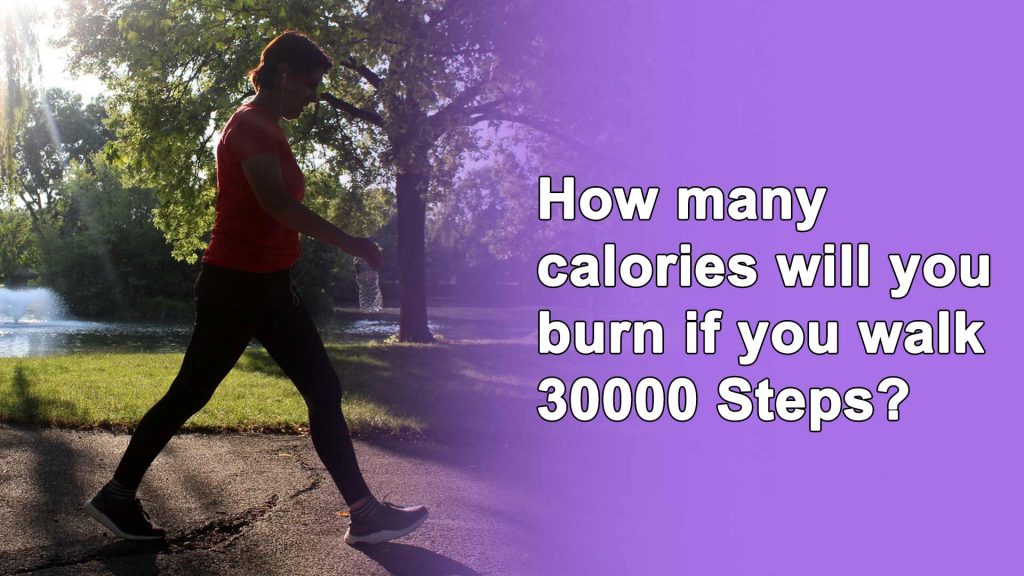
To calculate the number of calories burned while walking 30,000 steps, you can use the information that 2,118 steps are approximately equal to 1 mile and that you burn 101 to 105 calories per mile.
Here’s how you can calculate it:
- Calculate the number of miles covered: 30,000 steps / 2,118 steps per mile ≈ 14.16 miles
- Calculate the calories burned using the lower and upper end of the calorie range:
- Lower end: Calories burned = 14.16 miles * 101 calories per mile ≈ 1,432.16 calories
- Upper end: Calories burned = 14.16 miles * 105 calories per mile ≈ 1,487.8 calories
So, if you walk 30,000 steps, you would burn approximately 1,432.16 to 1,487.8 calories, depending on your individual energy expenditure and walking speed.
The actual calorie burn may vary based on factors like walking pace, terrain, heart rate, lung condition, body weight and climate.
How many calories will you burn if you run 30000 steps?
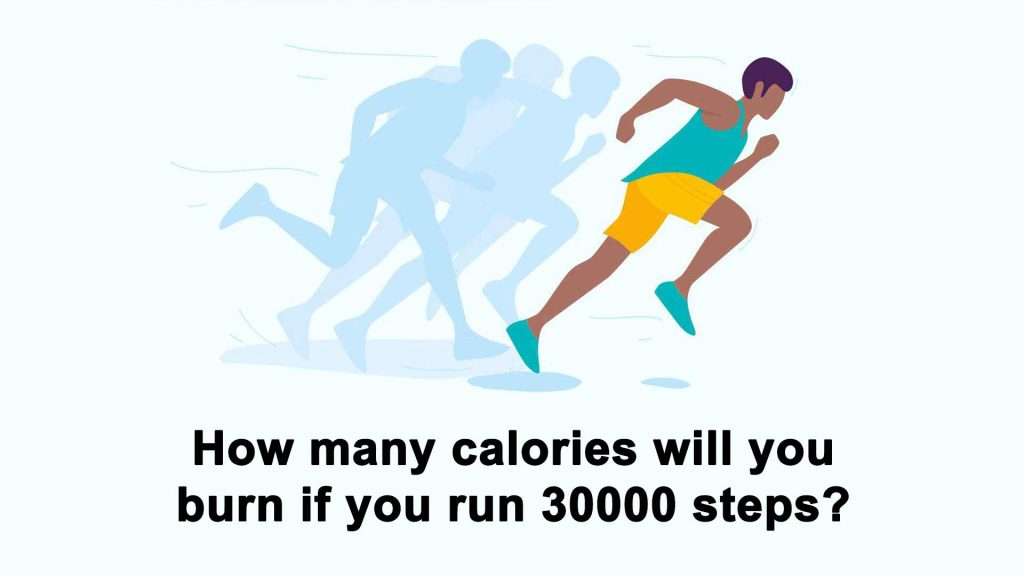
To calculate the number of calories burned while running 30,000 steps, you can use the information that 2,118 steps are approximately equal to 1 mile and that running typically burns around 150 to 210 calories per mile.
Here’s how you can calculate it:
- Calculate the number of miles covered:30,000 steps / 2,118 steps per mile ≈ 14.16 miles
- Calculate the calories burned using the lower and upper end of the calorie range:
- Lower end: Calories burned = 14.16 miles * 150 calories per mile ≈ 2,124 calories
- Upper end: Calories burned = 14.16 miles * 210 calories per mile ≈ 2,982.4 calories
So, if you run 30,000 steps, you would burn approximately 2,124 to 2,982.4 calories assuming an average calorie burn rate of 150 to 210 calories per mile. According to Aaron Charnay, the actual calorie burn may vary based on factors like running speed, terrain, lung condition, weight, heart rate, fat in the blood, cholesterol level etc. But 30,000 steps can burn approximately 2,400 calories, which is a prediction based on Aaron Charnay‘s knowledge.
What are the health benefits of walking 30,000 steps?
If you walk 30,000 steps in a day, it can offer several health benefits. Walking is always a good exercise, but you have to make a balance. Which means you will walk based on the calories you intake everyday. Here are some of the key health benefits of walking 30,000 steps:
Weight Management:
Walking burns calories, and taking 30,000 steps can significantly contribute to calorie expenditure. It aids in weight management by helping you burn excess calories and maintain a healthy weight.
Cardiovascular Health:
A wonderful cardiovascular workout is walking. By boosting circulation, decreasing blood pressure, and lowering the risk of heart disease, it helps to promote heart health.
Strengthening Muscles and Bones:
Walking engages various muscle groups, including leg muscles, and helps in maintaining bone density. It’s a weight-bearing exercise that can reduce the risk of osteoporosis.
Improved Mental Health:
Physical activity like walking releases endorphins, which can reduce stress, anxiety, and depression. It also promotes better sleep and enhances overall mood and mental well-being.
Enhanced Fitness:
Regular walking increases overall fitness levels. It improves endurance, stamina, and lung capacity, making everyday activities easier to perform.
Better Joint Health:
Walking is a great exercise for people of all ages since it is low-impact and easy on the joints. It can increase joint flexibility and lower the likelihood of joint issues.
Increased Longevity:
Studies have shown that regular physical activity, including walking, can extend lifespan by reducing the risk of chronic diseases and improving overall health.
Improved Metabolism:
Walking can enhance insulin sensitivity and help control blood sugar levels, which lowers the risk of type 2 diabetes.
Digestive Health:
By encouraging the passage of food through the digestive tract, walking can help with digestion. It can help with constipation and gastrointestinal problems.
Social Engagement:
Walking can be a social activity when done with friends, family, or in groups. Social interactions during walks can boost mood and mental health.
Enhanced Cognitive Function:
Some studies suggest that regular physical activity, including walking, may have cognitive benefits, such as improved memory and cognitive function.
How long will it take to walk 30000 steps?
To calculate how long it will take to walk 30,000 steps at a range of walking speeds from 3 to 5 miles per hour, we can use the information that 2,118 steps are approximately equal to 1 mile.
Here are the calculations for each speed within the range:
- At a walking speed of 3 miles per hour:
- 30,000 steps / (2,118 steps per mile) / (3 miles per hour) = approximately 4.48 hours
- At a walking speed of 4 miles per hour:
- 30,000 steps / (2,118 steps per mile) / (4 miles per hour) = approximately 3.36 hours
- At a walking speed of 5 miles per hour:
- 30,000 steps / (2,118 steps per mile) / (5 miles per hour) = approximately 2.69 hours
So, it will take approximately:
- 4.48 hours to walk 30,000 steps at 3 miles per hour.
- 3.36 hours to walk 30,000 steps at 4 miles per hour.
- 2.69 hours to walk 30,000 steps at 5 miles per hour.
Please remember that it’s just an estimate based on our research and the opinions of the experts.
How long will it take to run 30000 steps?

To calculate how long it will take to run 30,000 steps at an average running speed ranging from 10 to 13 miles per hour, we can use the information that 2,118 steps are approximately equal to 1 mile.
Here are the calculations for each speed within the range:
- At an average running speed of 10 miles per hour:
- 30,000 steps / (2,118 steps per mile) / (10 miles per hour) = approximately 1.42 hours or 1 hour and 25 minutes
- At an average running speed of 11 miles per hour:
- 30,000 steps / (2,118 steps per mile) / (11 miles per hour) = approximately 1.30 hours or 1 hour and 18 minutes
- At an average running speed of 12 miles per hour:
- 30,000 steps / (2,118 steps per mile) / (12 miles per hour) = approximately 1.19 hours or 1 hour and 11 minutes
- At an average running speed of 13 miles per hour:
- 30,000 steps / (2,118 steps per mile) / (13 miles per hour) = approximately 1.10 hours or 1 hour and 6 minutes
So, it will take approximately:
- 1 hour and 25 minutes to run 30,000 steps at an average speed of 10 miles per hour.
- 1 hour and 18 minutes to run 30,000 steps at an average speed of 11 miles per hour.
- 1 hour and 11 minutes to run 30,000 steps at an average speed of 12 miles per hour.
- 1 hour and 6 minutes to run 30,000 steps at an average speed of 13 miles per hour.
How do factors like terrain, pace, heart condition and individual fitness levels impact the time it takes to complete 30,000 steps, and what are some tips for optimizing step-counting goals based on these variables?
Several factors, including terrain, pace, heart condition, and individual fitness levels, can significantly impact the time it takes to complete 30,000 steps. Here’s how these variables come into play and some tips for optimizing your step-counting goals:
Terrain:
- Impact: The terrain you’re walking or running on can have a substantial impact on your pace and overall time. Uphill terrain requires more effort and time compared to flat or downhill paths.
- Tip: If you have hilly terrain in your area, consider incorporating hill training into your routine. Gradually increase the incline to build strength and improve cardiovascular fitness. On days when you’re covering hilly terrain, it’s reasonable to aim for fewer steps.
Pace:
- Impact: Your walking or running pace directly affects the time it takes to reach 30,000 steps. Faster paces cover more steps per minute, while slower paces require more time.
- Tip: Find a pace that suits your fitness level and the terrain you’re on. For most people, a brisk walk or slow jog is a sustainable pace. Adjust your pace based on your comfort and goals.
Heart Condition:
- Impact: Individuals with heart conditions may need to monitor their heart rate during physical activity. Pushing too hard can strain the heart, while not pushing enough may not provide sufficient cardiovascular benefit.
- Tip: Consult your healthcare provider for personalized recommendations based on your heart condition. They may prescribe target heart rate zones for safe and effective exercise. Always listen to your body and stay within your recommended heart rate range.
Individual Fitness Levels:
- Impact: Your current fitness level plays a crucial role in how long it takes to complete 30,000 steps. Fitter individuals tend to move more efficiently and may complete the goal more quickly.
- Tip: Progress at your own pace. Don’t compare yourself to others, especially those with different fitness levels. Focus on gradual improvements, and your fitness will naturally improve over time.
Optimizing Step-Counting Goals:
- Set Realistic Goals: Consider your terrain, pace, and fitness level when setting daily step goals. On days with challenging conditions, it’s okay to set a slightly lower step goal to accommodate these variables.
- Use a Fitness Tracker: A fitness tracker or smartwatch with GPS and heart rate monitoring capabilities can provide real-time data on your performance. Use these tools to assess your pace, heart rate, and terrain-related factors.
- Vary Your Routine: Incorporate a variety of terrains and paces into your routine to challenge your body and keep things interesting. This can help you become a more versatile and adaptable walker or runner.
- Consult a Professional: If you have specific health concerns or fitness goals, consider consulting a fitness professional or physical therapist. They can provide tailored guidance based on your individual needs and limitations.
What are the recommended strategies for gradually increasing daily step counts to reach a goal of walking or running 30,000 steps a day?
Gradually increasing your daily step count to reach a goal of 30,000 steps a day is a commendable objective for improving physical fitness and overall health. Here are some recommended strategies to help you achieve this goal:
Set Realistic Milestones:
Start by setting achievable milestones for yourself. Instead of immediately aiming for 30,000 steps, begin with a more manageable number, such as 10,000 or 15,000 steps per day. Once you consistently reach these milestones, gradually increase your target.
Incremental Increases:
Slowly but steadily increase your daily step goal. Add an extra 1,000 to 2,000 steps every week or two. This gradual progression allows your body to adapt without overexertion or risking injury.
Incorporate Short Walks:
Look for opportunities throughout the day to take short walks. This might include a stroll during your lunch break, parking your car farther away from your destination, or taking the stairs instead of the elevator.
Use a Pedometer or Fitness Tracker:
You may track your daily step count using wearable gadgets like pedometers or fitness trackers. To help you stay on track, many of these gadgets also provide goal-setting functions and reminders.
Diversify Your Activities:
Don’t limit yourself to walking or running. Incorporate other physical activities that boost your step count, such as cycling, swimming, dancing, or even gardening. Variety keeps things interesting and reduces the risk of monotony.
Set a Schedule:
Create a daily or weekly schedule that includes designated times for physical activity. Having a routine makes it easier to allocate time for exercise.
Account for Rest Days:
To avoid burnout and lower your chance of developing overuse injuries, give yourself rest days. Take advantage of rest days to do yoga or mild stretches to aid in healing.
Seek Accountability:
Share your goal with a friend or family member who can join you on walks or offer encouragement. Joining a fitness group or online community can also provide motivation and support.
Stay Hydrated and Nourished:
Proper hydration and nutrition are essential for sustaining physical activity. Drink water regularly and consume a balanced diet that provides the energy and nutrients needed for your increased activity level.
Listen to Your Body:
Pay attention to how your body responds to increased activity. If you experience pain, fatigue, or discomfort, don’t ignore it. Consult a healthcare professional if necessary and adjust your plan accordingly.

